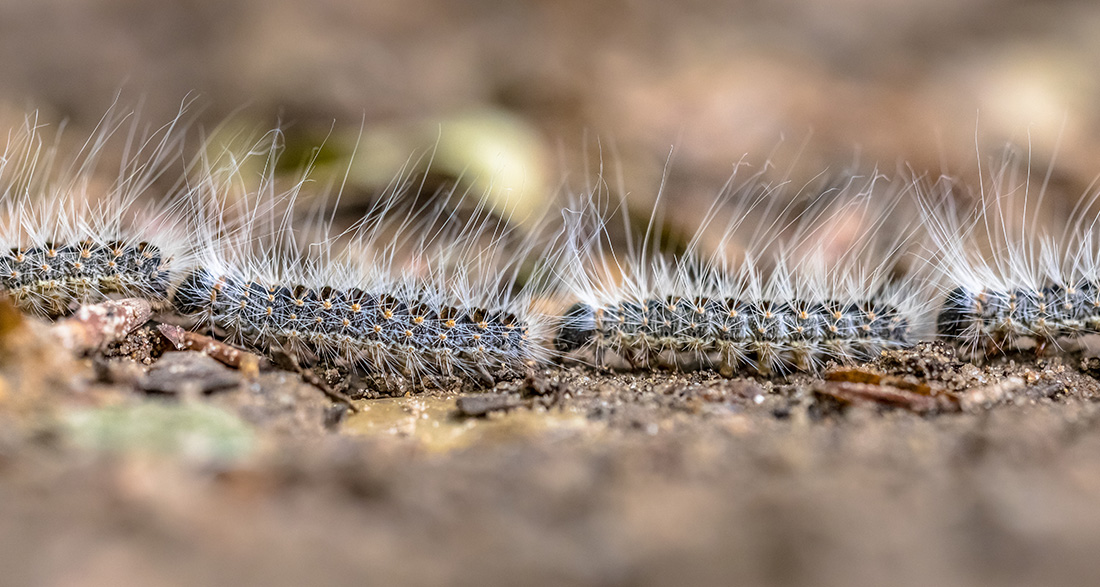In April and May, it begins: the oak processionary caterpillars settle on trees. Specialized services are in constant operation to tackle the infestation. Good news for dog owners, as the oak processionary caterpillar is not just a caterpillar species that transforms into a butterfly for dogs.
The issue with these caterpillars lies in the fine stinging hairs that contain the toxin Thaumetopein. This leads to caterpillar dermatitis upon contact, affecting both humans and dogs.
- Why are dogs at risk from oak processionary caterpillars?
- Symptoms after contact with the oak processionary caterpillar
- Where does the oak processionary caterpillar predominantly occur?
- How do dogs come into contact with the oak processionary caterpillar?
- What happens when dogs come into contact with the stinging hairs?
Why are dogs at risk from oak processionary caterpillars?
Emergency at a veterinary practice: A dog, visibly drooling and having trouble drinking, arrives at the vet. Through a thorough examination, the veterinarian determines that the dog has come into contact with the stinging hairs of the oak processionary caterpillar. A portion of the tongue could not be saved – that’s how potent the toxin is for dogs. The main problem: The stinging hairs still contain the toxin even after detaching from the caterpillar’s body. Wherever these nests and pine trees are found, the stinging hairs can be dispersed in the environment. Simply by sniffing around, dogs can come into contact with them.
The following times are particularly critical for your dog:
- Late April to early May: The caterpillars develop their first stinging hairs.
- Mid-May to late June: The oak processionary caterpillars shed their hairs, which are carried out of the nests by the wind.
Symptoms after contact with the oak processionary caterpillar
Depending on the type of contact, dogs can exhibit different symptoms when exposed to the oak processionary caterpillar. The dog’s skin reacts to the stinging hairs with:
- Intense itching
- Pustules
- Redness
- Formation of welts
It becomes more problematic when your dog inhales the hairs of the oak processionary caterpillar or has them on the tongue. This can lead to:
- Eye irritation
- Fatigue
- Fever
- Dizziness
If you observe symptoms of this nature, you must take your pet to the vet. While these symptoms could also indicate other forms of allergies, only a veterinarian can accurately determine the cause.
Tip:
A pet health insurance covers the costs of veterinary treatment. Therefore, you don’t need to be hesitant about the cost risk of thoroughly examining your dog for exposure to the stinging hairs.
Where does the oak processionary caterpillar predominantly occur?
From the third larval stage onward, the stinging hairs on the caterpillar’s back contain the allergenic toxin Thaumetopein. Simply due to wind movement, these hairs break off and spread hundreds of meters. This critical larval stage typically begins when it is dry and warm for an extended period. Experts cannot precisely pinpoint this. Generally, we can expect oak processionary caterpillar infestations from mid-May onwards.
However, this timeframe regularly shifts due to climate change. Particularly in unusually warm Mays, the growth of caterpillars is favored. These caterpillars are predominantly found on oak trees, with southern regions more commonly affected. Nevertheless, climate change indicates an increase in occurrences even in northern States.
How do dogs come into contact with the oak processionary caterpillar?
During their walks, dogs exhibit an extensive sense of exploration. It’s natural for them to sniff around wherever there are interesting scents. This can become a significant danger in areas affected by the oak processionary caterpillar. As the name suggests, this caterpillar predominantly settles on oak trees. Just sniffing in oak leaves is enough to cause contact poisoning. The stinging hairs still contain toxin even after falling off. If the stinging hairs are now on the dog’s fur, they trigger itching, the initial signs of external poisoning. The dog licks the affected area, and the stinging hairs are absorbed through the mucous membranes.
What happens when dogs come into contact with the stinging hairs?
You can take initial measures if it’s clear that your dog has come into contact with the oak processionary caterpillar and its stinging hairs. It’s advisable to carry a large bottle of water during this season to perform emergency rinsing of the eyes, nose, and mouth if needed. Ensure that your dog comes home after this initial measure. Spray him off in the garden or bathtub. Use disposable gloves to avoid contact with any remaining stinging hairs.
If the mentioned symptoms persist or worsen, it’s crucial to consult a veterinarian.


